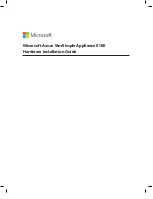
xv
Appendix B - Drive Reformat Instructions
Windows 7/Server 2008/Vista Users’ Instructions
(continued)
10.
Click Start, then right-click Computer and select Manage.
11.
In the
Computer Management
window, click Storage in the
left pane to expand the list (if necessary), and then click Disk
Management.
12.
When the
Initialize Disk
window appears, select the RAID
volume you created. Select the GPT partition style unless you
need to access your RAID storage from a computer running
32-bit Windows XP Professional or 32-bit Windows Server
2003. Click OK.
13.
In the
Disk Management
window, each RAID group you
created will appear (listed as “unallocated”) as a single volume.
Right-click where the word “unallocated” appears, and then
select New Simple Volume.
14.
When the Welcome to the
New Simple Volume Wizard
window
appears, click Next to start the process.
15.
When the
New Simple Volume Wizard
window appears, click
Next.
16.
When the
Specify Volume Size
window appears, click Next if
you want all of the Fusion system’s capacity to remain as one
block (volume). Otherwise, adjust the volume size to meet
your needs, and then click Next.
17.
When the
Assign Drive Letter or Path
window appears, select
Assign the following drive letter, choose a letter, and then
click Next.
18.
When the
Format Partition
window appears, enter a new
name for the volume table if you’d like. For RAID volumes
up to 16TB, accept the default allocation unit size; for RAID
volumes greater than 16TB, select 8192 from the drop-down
menu. Select Perform a quick format, and then click Next.
Note:
If you do not select the quick format option, this process will take
much longer to complete.
19.
When the next window appears, click Finish.
20.
Repeat steps 13–19 for each remaining “unallocated” disk.
21.
Depending on how you configured the RAID groups, the
volumes may already be available to the system. If you
created a DVRAID, RAID 4, RAID 5, or RAID 6 RAID group,
configuration will take much longer. You may check on the
process by double-clicking the volume name in the lower
pane of the
ATTO Configuration Tool
window.
22
. Once all the RAID groups have been formatted and finish
building, they are ready to use.
Windows XP/Server 2003 Users’ Instructions
1.
Follow all the steps in the included documentation to install
the software and the Sonnet RAID controller, and to set up
and connect the Fusion RAID enclosure.
2.
Start your computer, and then turn on the Fusion drive
enclosure.
3.
Launch the ATTO Configuration Tool.
4.
Expand the device tree in the Device Listing section on the
left side of the window until ExpressSAS Rxxx is displayed,
and then click ExpressSAS Rxxx.
5.
Click the RAID tab.
6.
In the Groups pane, you will see the RAID group that
Sonnet created (not usable in a Windows system); click the
group.
7.
Select RAID Management > Delete Group from the
application menu.
8.
When the
Delete Confirmation
window appears, click Yes.
9.
Set up new RAID groups following the instructions on pages 9
and 10.
10.
Select Start > Control Panel from the Windows Start menu. In
the
Control Panel
window, double-click Administrative Tools.
In the
Administrative Tools
window, double-click Computer
Management.
11.
In the
Computer Management
window, click Storage on the
left, and then click Disk Management beneath it.
12.
When the
Initialize and Convert Disk Wizard
window appears,
click Cancel.
13.
In the
Disk Management
window, each RAID group you
created will appear (listed as “unallocated”) as a single volume.
Right-click one volume where the words “Not Initialized”
appear, and then select Initialize Disk.
14.
When the
Initialize Disk
window appears, select the RAID
volume(s), and then click OK.
15.
Back in the
Disk Management
window, right-click where the
word “Online” appears, and then select Convert to GPT Disk.
WARNING:
After selecting the DVRAID, RAID Level 4,
RAID Level 5, or RAID Level 6 option,
configuration of
the drives will take several hours to complete, with the
total time depending on the operating system and drive
capacities.
Summary of Contents for Fusion RAID Storage Systems
Page 1: ...Configuration Tool and Utilities Operation Manual for Fusion RAID Storage Systems ...
Page 2: ......
Page 28: ...22 ...
Page 38: ...32 ...
Page 56: ...50 1 9 SNMP Configuration Figure 34 Editing the trap destination ...
Page 58: ...52 ...
Page 60: ...54 Figure 35 Drive Performance window before starting the test 2 0 Drive Performance Testing ...
Page 64: ...58 ...
Page 81: ...xvii ...




































